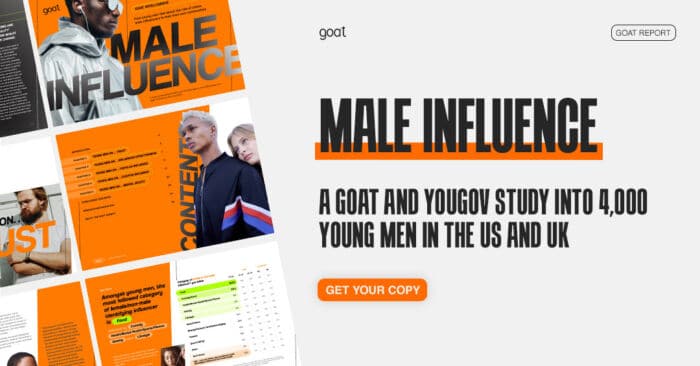Over the past decade, the conversation surrounding online male influencers has taken a negative turn.
From concerns around “toxic masculinity” to worries over their impact on mental health, we mainly tend to hear about the dark sides of social media as it pertains to men.
But how do young men themselves feel about it?
As one of the world’s leading social and influencer marketing agencies, we’ve helped brands to reach and engage young men all over the world through creator-led campaigns. So, as we approach the second half of the 2020s, and as conversations around “male influence” continue to heat up, we decided to ask young men some burning questions directly.
Partnering with YouGov, we’ve surveyed 4,000 young men, aged 18-34, across the US and UK, revealing their thoughts on a range of topics and themes surrounding social media, influencers, and their impact on communities. Download a copy for the full key findings.

Contents
The State of Trust Among Young Men on Social Media: What Marketers Need to Know
The Effectiveness of Influencers: How to Make Your Brand Stand Out
The Evolving World of Influencer Categories: What Young Men Are Really Following
Positive Influence: How Young Men Are Seeking Better Role Models
Mental Health: Young Men and the Impact of Social Media
Concluding Thoughts: Shaping a Positive Future for Young Men in the Digital Age
The State of Trust Among Young Men on Social Media: What Marketers Need to Know
Trust is a key factor in how young men engage with media and influencers on social media. A recent survey sheds light on the level of trust this demographic places in digital content, offering valuable insights for marketers aiming to connect with them.
Trust in News and Media
Young men are generally skeptical of the news they consume. Only 47% trust news outlets, with 23% expressing distrust. This skepticism is stronger in the US (43% trust) compared to the UK (52%). Trust in social media is even lower: just 25% of young men believe the content they see on platforms like Instagram, TikTok, or X is truthful. This highlights a significant credibility gap that platforms must address.
Trust in Influencers
Interestingly, trust in influencers is higher. 43% of young men believe the influencers they follow are truthful, a marked contrast to their distrust of social media as a whole. Only 22% express skepticism about the authenticity of the influencers they engage with. Trust in influencers varies by age: men aged 25-34 tend to trust the platforms more than younger men, who are more likely to place their trust in the influencers themselves. This suggests that personality-driven content plays a critical role in building trust.
Changing Social Media Habits
Another important trend is that 24% of young men have switched their primary social platform to improve their online experience. This suggests that they are actively seeking platforms with more trustworthy or enjoyable content.
To build trust with young men, marketers must approach this demographic strategically over the next five years. Here are some key recommendations:
- Partner with Credible Creators
Collaborate with influencers who demonstrate authenticity and integrity. Look beyond follower count—evaluate the content, engagement, and reputation of influencers. Platforms like Reddit can provide additional insights into how influencers are perceived by real people. - Ensure Brand-Influencer Fit
Authenticity is crucial. Choose influencers whose values align with your brand, ensuring their endorsement feels natural. Even unexpected collaborations can succeed if they resonate with the audience and feel genuine. - Maintain Consistent Brand Messaging
Consistency is essential for building long-term trust. While creativity and bold campaigns are important, your brand’s core identity should remain clear and consistent across all platforms. Disjointed or confusing messaging can erode trust and alienate your audience.
The Effectiveness of Influencers: How to Make Your Brand Stand Out
Influencer marketing remains a vital strategy for reaching younger audiences, but as the social media space becomes more crowded, not all collaborations are equally effective. Insights from a recent survey of young men reveal key trends and offer valuable recommendations for brands looking to optimize their influencer partnerships.
Trust and Recognition of Influencer Partnerships
A significant 64% of young men can easily identify when an influencer is paid to promote a brand, reflecting growing consumer awareness and transparency around influencer marketing. Only 12% don’t notice paid partnerships, signaling that these collaborations are no longer as subtle as they once were. However, 20% of young men can’t recall any brand-influencer partnerships, indicating that many campaigns fail to make a lasting impact.
Regional Differences in Influencer Recall
Recall rates for influencer partnerships differ between the US and UK. In the US, 54% of young men can remember specific influencer campaigns, compared to 44% in the UK. This may be due to the more established influencer culture in the US. Additionally, more young men in the UK report not following any influencers, which could explain their lower recall rates.
Recommendations for Marketers
Despite concerns over the “downfall of the creator economy,” influencer marketing remains a potent tool when executed strategically. To ensure campaigns resonate and stand out, brands should focus on the following:
- Think Beyond the Trend
Influencer marketing should be an integral part of your campaign from the start, not just an afterthought. Choose influencers who align with your brand’s goals and create content that’s social-first, engaging from the outset. Data is valuable, but intuition and creative insight also play a crucial role in crafting effective campaigns. - Be Bold and Innovative
To capture attention in a crowded digital space, break the mold with unexpected influencer partnerships. If your brand typically works with a specific type of influencer (e.g., athletes for sportswear), consider mixing it up. Surprising collaborations can intrigue audiences and lead to more memorable content. This “Oddball Effect” taps into the psychological impact of novel or unexpected content, which tends to hold attention longer. - Consistency is Key
In a world overloaded with content, repetition is essential. Even if consumers don’t consciously remember every influencer partnership, consistent exposure influences their decisions over time. A layered influencer strategy that guides customers from awareness to conversion can build brand recognition and loyalty.
The Evolving World of Influencer Categories: What Young Men Are Really Following
Young men follow a diverse array of influencers on social media, spanning entertainment, politics, business, and more. Understanding these varied interests is essential for brands looking to build meaningful connections with this audience.
The Most Followed Influencer Categories
Comedy and music remain the dominant categories for young men, but their interests are expanding. Many follow influencers in food, fashion, sports, and film. A significant shift is also evident: 35% of young men engage with political influencers, and 27% follow content on entrepreneurship, finance, and business. This indicates that young men aren’t just seeking entertainment—they’re looking for advice and perspectives on important life decisions. Regional differences are also apparent, with US men more likely to follow tech influencers, while UK men gravitate toward food and fitness.
Shattering Stereotypes of Young Men’s Influencer Preferences
The stereotype that young men only follow influencers in niche categories like gaming or fitness is increasingly outdated. Over 25% of young men in the US follow fashion influencers, and nearly 30% are interested in film, theater, or acting. More than 88% of young men follow influencers across various categories, with 92% of those aged 18-24 engaging with multiple types of content. This diverse range of interests shows that young men are engaging with a wide variety of content, not just stereotypical topics.
Female and Non-Male Influencers
Another interesting trend is the growing engagement with female and non-male identifying influencers. Food influencers top the list, followed by comedy, health/mental health, sports/fitness, and lifestyle. This reflects a shift away from traditional gender roles, as young men embrace a broader spectrum of content from diverse creators. Female influencers, in particular, are gaining traction, offering brands an opportunity to break stereotypes and connect with a more inclusive audience.
The Rise of “Tradwife” Influencers
A surprising trend is the rise of “Tradwife” influencers—women who embrace traditional gender roles, focusing on homemaking and family life. Influencers like Nara Smith and Hannah Neeleman (@BallerinaFarm) have popularized this niche, which has sparked both interest and controversy. About 13% of young men follow Tradwife influencers, showing that even niche or controversial categories can capture attention. This trend reflects the diversity of preferences within the young male demographic, even in areas where traditional gender roles are challenged.
Key Takeaways for Brands:
- Avoid Stereotyping
Brands must avoid stereotyping when targeting young men. While fitness and gaming influencers are popular, many young men also follow a broad range of creators, including female and non-male influencers in various fields. By diversifying influencer partnerships, brands can reach a more inclusive and wider audience. - Balance Established and New Niches
Brands should balance familiar influencers with emerging niches. While well-known influencers should remain part of campaigns, testing new creators and concepts helps keep content fresh and relevant. Using data-driven tools, like IBEX at Goat, can help predict which influencers will drive the best results for a campaign. - Leverage Comedy and Humor
Comedy remains a top interest, with nearly 40% of young men following comedy influencers. Integrating humor into influencer campaigns can make content more relatable and engaging. Whether through playful messaging or partnering with comedic influencers, humor can boost a brand’s connection with this audience.
Positive Influence: How Young Men Are Seeking Better Role Models
Social media has a profound influence on young men’s perceptions of themselves, masculinity, and society. While it offers opportunities for connection and growth, it also shapes views in ways that can be harmful. A recent survey reveals concerns among young men about the negative effects of social media, as well as a strong desire for more positive representation. Brands and influencers can leverage these insights to create content that resonates with this audience in a meaningful way.
The Negative Impact of Social Media
Social media’s impact on young men’s outlook is troubling. Nearly one-third (28%) of men aged 18-24 feel social media has given them a more negative view of men’s role in society, with 27% feeling it has led to a more negative perception of men in general. This trend is even more pronounced in the UK, where 50% of young men report social media negatively affecting their worldview, compared to 36% in the US. Furthermore, 43% of young men aged 18-34 feel social media contributes to a more negative view of the world overall, often leading to feelings of disillusionment and disconnection.
Concerns About Masculinity and Social Issues
A key concern is the way masculinity is portrayed on social media. Over half (52%) of young men believe that the way masculinity is depicted contributes to societal problems such as toxic masculinity, unrealistic body image expectations, mental health issues, bullying, and gender inequality. These negative portrayals are felt within their communities, and many young men are seeking healthier models of masculinity.
The Search for Positive Role Models
Despite these negative influences, there is a strong desire among young men for more positive role models on social media. More than half (53%) of young men aged 18-24, and 47% of those aged 25-34, are actively seeking out influencers who offer positive, constructive models of masculinity. The qualities most valued in positive male role models include kindness, empathy, compassion, and inspiration. Physical health, fitness, and humor also rank highly, particularly among younger men (46% of 18-24-year-olds). However, financial success, career achievements, and large online followings are less important, with only 30% of young men viewing wealth as essential to being a positive role model—this drops even further among US respondents.
Desire for Positive Content
The demand for positive role models is clear. A striking 70% of young men want to see more content from influencers they consider good role models. Furthermore, 67% believe that positive male role models are often overlooked by the media, brands, and society. Nearly half (49%) of young men are already actively searching for influencers who embody the qualities they admire, with the number rising to 53% among US respondents and 53% among 18-24-year-olds. This signals a strong appetite for content that showcases healthy and supportive representations of masculinity.
Recommendations for Brands and Influencers:
- Prioritize Positive Representation
Brands should make positive representations of masculinity a central part of their campaigns. Consider whether your influencer partnerships reflect the qualities young men value, such as kindness, empathy, and openness. Engaging in a dialogue with your audience and including diverse creators will help promote more positive portrayals of masculinity. - Choose Influencers Who Embody Positive Qualities
Young men are searching for role models who exhibit kindness, humor, and empathy, and who are open about mental health. When selecting influencers, ensure they align with these values and promote a balanced approach to physical and mental well-being, healthy relationships, and personal growth. - Align Campaign Creative with Positive Values
It’s not just about the influencers you partner with; the content you create matters too. Ensure your campaigns reflect the values that resonate most with young men—whether through messaging, visuals, or tone. This alignment will strengthen your connection with this audience. - Support Positive Influencers
By championing influencers who promote kindness, empathy, and mental health awareness, brands can help reshape the conversation around masculinity. These positive role models can shift societal perceptions and create a healthier, more inclusive definition of manhood.
Mental Health: Young Men and the Impact of Social Media
Social media has become an integral part of young men’s lives, shaping their self-image, mental well-being, and worldview. However, many are increasingly concerned about its negative impact on their mental health. Understanding these concerns can help brands and influencers create more supportive and authentic content that resonates with this audience.
Concerns About Social Media’s Impact on Mental Health
A significant 70% of young men express concern about social media’s effect on their mental health, with 76% in the UK and 65% in the US sharing similar worries. These concerns span both Gen Z and Millennial age groups, indicating that the negative impacts of social media are felt across generations. Young men are particularly concerned about the pressure to live up to idealized portrayals of masculinity and the mental strain caused by constant exposure to unrealistic content.
Unrealistic Representations in Social Media Advertising
Half of the respondents (50%) feel that portrayals of men’s fitness, wealth, and beauty in social media advertising make them feel inadequate or disconnected from reality. Only 16% disagreed. This shows that many young men struggle with the pressure to meet unattainable standards of masculinity, often set by influencers and brands. These unrealistic portrayals can contribute to feelings of self-doubt and mental strain, making it crucial for brands to reassess their marketing approaches.
Exposure to Offensive Content
Another concern is the exposure to derogatory or offensive content on social media. Approximately 19% of young men feel desensitized to such content, while 27% ignore it, believing it doesn’t affect them directly. However, 31% report feeling upset, angry, or sad when exposed to offensive comments or content, even if they don’t engage directly. A smaller group (13%) actively comments on or challenges offensive content, while 33% block individuals who share it. This complex relationship highlights the discomfort many young men feel but their perceived powerlessness in addressing harmful content.
Trusting Influencers for Mental Health Advice
Interestingly, 20% of young men trust the influencers they follow for mental health advice, with this number rising to 23% in the US. However, trust in healthcare professionals remains stronger, especially in the UK, where 50% trust doctors compared to just 17% who trust influencers. Despite this, family (62%) and friends (53%) remain the most trusted sources for mental health guidance, presenting an opportunity for brands and influencers to complement these networks of support.
Recommendations for Brands and Influencers:
- Promote Realistic Representations of Masculinity
Many young men feel that social media often portrays unattainable ideals. Brands should review their campaigns to ensure they portray authentic and grounded representations of masculinity. Avoid amplifying unrealistic standards around fitness, wealth, and beauty, as this can alienate young men who don’t see themselves reflected in these ideals. - Balance Aspiration with Attainability
Young men appreciate aspirational content, but it must feel achievable. Brands should strive to empower young men to improve themselves without making them feel inadequate. Messaging should motivate without reinforcing unattainable standards, fostering confidence rather than insecurity. - Monitor Platform Usage and Adapt Accordingly
Approximately 24% of young men are switching platforms to find a more positive online experience. Brands should reassess the platforms they use for influencer marketing and ensure they align with where their audience feels most comfortable. Focusing on platforms that prioritize mental well-being may be key to maintaining positive engagement. - Encourage Vulnerability and Openness About Mental Health
Young men want to see influencers who are open about their struggles and promote kindness and mental health awareness. By partnering with influencers who show vulnerability, brands can create a more supportive space for young men, making their campaigns feel more authentic and relatable. - Prioritize Diversity and Inclusion
Campaigns should be inclusive, reflecting the varied experiences of young men. Representation should go beyond gender and ethnicity to include body diversity, mental health awareness, and other aspects of young men’s lives. Inclusive campaigns challenge stereotypes and help foster a more supportive, empathetic online community.
Concluding Thoughts: Shaping a Positive Future for Young Men in the Digital Age
The insights gathered from our survey reveal a complex and nuanced relationship between young men and social media. While concerns about mental health, unrealistic portrayals of masculinity, and the overwhelming nature of online content persist, there is a clear shift toward seeking more positive and authentic representations. Young men are not only looking for entertainment, they are also searching for inspiration, mental health support, and healthier role models who embody qualities like kindness, empathy, and vulnerability.
As brands and influencers, we have an opportunity and responsibility to respond to these needs by prioritizing authenticity, positive masculinity, and inclusivity. Young men are actively seeking content that supports their mental well-being, challenges harmful stereotypes, and encourages personal growth. By focusing on partnerships with credible, diverse influencers and creating campaigns that reflect the values of this demographic, we can help foster a more supportive and empowering online environment.
Ultimately, the future of influencer marketing lies in the ability to connect with young men on a deeper level, acknowledging their struggles while uplifting their strengths. By evolving with their needs, brands can not only build lasting trust and loyalty but also contribute to shaping a healthier digital landscape for the next generation.





